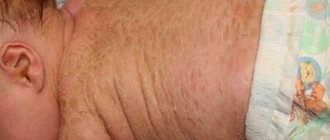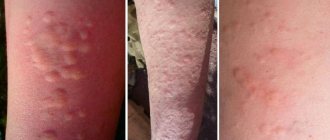The carbuncle is most often located on the back of the neck, lower back, and hips.
Purulent inflammation is acute and requires immediate treatment. Below in the article you will find the causes of the disease; the doctors who treat him; necessary medical procedures for treatment; as well as general information about the disease, its localization, features of diagnosis of diseases and their treatment. However, we advise you to consult a doctor, because self-medication in 90% of cases is fraught with the disease progressing to the chronic stage with extremely unpleasant complications. Make an appointment and consultation
1.General information
Carbuncle is one of the common types of infectious and inflammatory skin lesions. The name comes from the ancient Greek "carbon" (coal) and is based on an association with a smoldering coal, which can be caused by the appearance of a blackened focus of purulent-necrotic tissue decay in combination with inflammatory hyperemia, and sometimes bleeding.
The carbuncle differs from clinically similar ulcers in the tendency for the inflammatory process to quickly spread to several hair follicles simultaneously, which creates the precondition for further expansion, and under unfavorable conditions (for example, against the background of diabetes mellitus or weakened immunity) it can result in sepsis, meningitis, phlegmon and other life-threatening diseases. states.
Carbuncles occur in all age categories, but there is a statistical predominance of young people (which is explained by the characteristics of hormonal activity and secretory function of the sebaceous glands), and the male gender predominates.
A must read! Help with treatment and hospitalization!
Carbuncle. general information
Carbuncle is an acute purulent inflammation of the skin with subcutaneous fat that occurs around several hair follicles. The disease is most often acute and requires immediate treatment. The lesions are usually located on the back of the neck, lower back, hips - those places where the edges of clothing come into contact with the skin and hair. This creates conditions for infection to penetrate the hair follicle.
When treating Carbuncles, doctors at the BIOSS clinic use both time-tested and the latest developments and proprietary techniques.
The BIOSS MC employs the best doctors in Moscow who have extensive experience in the treatment of carbuncles
2. Reasons
Carbuncle is a typical focal staphylococcal infection. The pathogen is usually Staphylococcus aureus, less often other types of staphylococcus; Even more rarely, streptococcus or a polymicrobial infection is cultured, where staphylococci are again present, and only in isolated cases are other bacterial pathogens found.
Risk factors include hyperfunction of the sebaceous glands, the presence of microtraumas, cracks and abrasions on the skin, prolonged physical activity in polluted areas or in dusty air, as well as the presence of underlying diseases with metabolic disorders and/or a decrease in general resistance and local immunity.
Visit our Dermatology page
Medicines
Photo: obaldela.ru
Outpatients are prescribed broad-spectrum antibiotics in tablets. During hospitalization, drugs are administered intramuscularly. General antibiotic therapy is supplemented by injecting the carbuncle with medications. Pain syndrome is eliminated with the help of analgesics. The choice of painkillers is made taking into account the severity of the symptom; it is possible to use NSAIDs, analgin, ketorol, and in severe cases, short-course narcotic analgesics.
The surface of the unformed carbuncle is treated with an alcohol solution, streptomycin or synthomycin emulsion. After opening the abscess, the above-mentioned proteolytic enzymes are used, then antibiotic ointments are used. To increase the body's defenses and accelerate wound healing, immunomodulators, ascorbic acid, and vitamins A and B are prescribed. In severe cases of the disease, plasma infusions are performed with the addition of anti-staphylococcal antibodies.
3. Symptoms and diagnosis
The lesion usually forms on the face, neck, back, buttocks, although theoretically the location can be any.
A small painful “cluster” of internal infiltrates appears, which soon combine into a purplish-black abscess protruding above the skin with spontaneously erupting outlets of greenish pus. The surrounding skin is inflamed and reacts to palpation with acute pain. Purulent melting and necrotization reaches the deep layers of the skin, and sometimes subcutaneous structures, resulting in the formation of an ulcer, which subsequently becomes roughly scarred, leaving a cosmetic defect on the skin. The full cycle of development and resolution of the carbuncle varies from 3 to 5 weeks.
In many cases, pain and general toxic symptoms characteristic of bacterial infections are expressed: febrile temperature, febrile state, weakness, headache, nausea, sleep disturbances, etc. In some cases, intoxication is so strong that it leads to depression of consciousness. Malignant development with the formation of multiple carbuncles, the addition of purulent meningitis, phlegmon, sepsis in a weakened and immunodeficient group of patients often ends fatally.
The diagnosis is established by a dermatologist clinically, based on the results of examination, analysis of complaints, dynamics and anamnestic information. If differential diagnosis is necessary and to determine the sensitivity of the pathogen to antibiotics, a laboratory bacteriological study is performed.
About our clinic Chistye Prudy metro station Medintercom page!
DIAGNOSIS OF CARBUNCLE
In medical practice, there are no difficulties in diagnosing a carbuncle. But there are cases when it is necessary to differentiate from anthrax, called anthrax carbuncle.
The clinical picture at some stages is similar, and this is facilitated by the development in some cases of a necrotic crust carbuncle. Sometimes there are only minor reactions around the boil site, but this is quite rare. If there is any doubt, doctors prescribe a bacterioscopic examination.
If the clinical picture does not give an accurate picture, then in order to diagnose a carbuncle or furuncle, blood tests are performed - leukocytosis, an increase in ESR, a shift to the left in the leukocyte formula.
4.Treatment
In most cases, it is possible to interrupt the infectious-inflammatory process with the help of antibiotic drugs (orally and locally) in combination with physiotherapy. However, in more severe, advanced, prognostically dangerous cases (for example, when the carbuncle is localized on the face, multiple carbunculosis, rapidly progressing necrosis, as well as in patients at high risk), hospitalization and surgical intervention are necessary.
The carbuncle is opened and necrotic material is removed, observing maximum antiseptic measures and subsequent intensive antibacterial therapy to avoid relapse and further spread of the infection.
Symptoms of a boil
- The disease begins with a slight tingling sensation, changes in sensitivity (numbness) of a certain area of the skin, chills and a slight increase in body temperature.
- Pain, swelling and redness of the skin appear with the formation of a dense nodule with a diameter of up to 2 cm.
- Then, in the center of this nodule, corresponding to the exit of the hair, a so-called rod (a section of dead tissue) appears, which is gradually torn away, after which the wounded defect is cleared of pus and heals with the formation of a scar.
- With a boil in the area of the upper lip, nose, nasolabial folds and bridge of the nose, there is a high risk of infection spreading with the development of purulent meningitis and sepsis. Over the course of 1–2 days, an inflammatory infiltrate forms. A facial boil is accompanied by severe swelling, although the pain may be minor.
Folk remedies
Photo: fittedmagazine.com
You should not use local methods (lotions, compresses) on your own, because choosing treatment methods without taking into account the severity and stage of development of the abscess can cause severe complications. At home, it is recommended to use safer general remedies:
- Brewer's yeast . The high content of amino acids, vitamins B and D helps the body fight infection and eliminate toxins faster. Yeast is taken before meals 3 times a day in the amount of 1 teaspoon.
- Chicory . It has an immunostimulating effect, contains useful vitamins and minerals, and has antimicrobial and anti-inflammatory effects. Pour 2 teaspoons of chicory root into a glass of boiling water, leave for 2 hours, then consume a third of a glass 3 times a day.
To increase immunity, rose hip tea, cranberry juice, infusion of ginger and lemon, infusion of sea buckthorn with lemon and honey, and a decoction of bay leaves are useful. Before using any folk recipe, you should consult your doctor to rule out contraindications.
The information is for reference only and is not a guide to action. Do not self-medicate. At the first symptoms of the disease, consult a doctor.
How to treat a carbuncle on the buttock
A small carbuncle on the buttock can be treated on an outpatient basis. When you contact our clinic, the surgeon will conduct an examination and prescribe treatment on an outpatient basis.
- Antibiotics are prescribed to eliminate the infectious process. The drugs are injected intramuscularly into a healthy buttock. An effective method used in our clinic is local injection of antibiotics into the affected area.
- At the infiltration stage, the sore spot is treated with alcohol-based antiseptic solutions, after which a sterile bandage is applied.
- After opening the carbuncle naturally or surgically, bandages with proteolytic enzymes or hypertonic sodium chloride solution are applied to the wound, which help reduce swelling and reject pus and necrotic masses.
To improve the healing process and increase immunity, ultraviolet blood irradiation, plasmapheresis, and immunomodulatory drugs are used.
Diagnostic methods in surgery:
- Doppler in surgery
- Colonoscopy
- Angiography
- CT scan
- Gastroscopy
- MRI
- Abdominal ultrasound
- X-ray
- Endoscopy
Prices:
| Code | Name of service | Prices |
| 1 | Initial appointment | 1200 |
| 2 | Repeated appointment | 900 |
| 3 | Calling a surgeon to your home | 3500 |
| 4 | Abdominal ultrasound | 2200 |
| 5 | Ultrasound of veins and vessels | 2400 |
| 6 | Doppler 2-3 trimester | 1200 |
| 7 | Rectoscopy | 1500 |
What kind of disease is this?
This formation received its name from the Greek word “ Carbo ”, which means black coal.
The healers of those times, having seen what a pimple looked like, immediately “christened” it that way because of the accumulation of black purulent-necrotic exudate at the site of its formation.
In practice, it is difficult for people without medical education to distinguish between a boil and a carbuncle , the difference being the larger area of infiltration and the depth of the lesion. In simple terms, a carbuncle is a cluster of boils, which over time form a single affected area with signs of suppuration. But individual furunculous formations can open spontaneously, but the focus of suppuration in the carbuncle cannot break out without surgical intervention.
Carbuncle occurs most often in teenage boys and young men (2 times more often than in girls, young women and women), apparently this is due to excessive load on their sweat and sebaceous glands and the active production of sex hormones in the body.
Another feature of this pathology is that more than 50% of all diagnosed cases occur in the hot summer period.
Carbuncles usually appear on the face and neck, on the back, in the forearms, on the arms or legs, and on the buttocks. As a rule, these formations are single, but sometimes several appear at once.
How to treat a carbuncle is determined by the surgeon, since this is a serious infection that requires the attention of medical workers and self-medication can lead to the development of serious complications (abscesses, cellulitis, sepsis).
Kinds
- A traditional carbuncle forms on the face, body, limbs and torso and develops according to classical canons in several stages.
- Kidney carbuncle . Occurs as a complication after suffering pyelonephritis. Its manifestation is similar to inflammatory kidney diseases and is sometimes difficult to distinguish from them. Symptoms of the disease include fever, intoxication and pain in the lumbar region. Differential diagnosis using X-ray and ultrasound methods helps to identify pathology.
- Emphysematous carbuncle . It does not develop in humans; it affects cattle. When infected with a pathogenic microorganism, many swellings are found on the body of animals, they quickly weaken and die from cardiac and respiratory failure.
- Anthrax carbuncle . It is formed when a person is infected with the anthrax bacillus, has a severe course and is extremely contagious to others.
Furunculosis
Furunculosis is an infectious disease characterized by the appearance of several boils at the same time (acute furunculosis) or the appearance of one boil after another (chronic furunculosis). With chronic furunculosis, the presence of boils at different stages of development is noted. Furunculosis can be limited or widespread. The disease lasts a long time - months and even years. Furunculosis often affects people with reduced immunity and those suffering from diabetes. During treatment, tolerance to the therapy with antibacterial drugs is noted.
Furunculosis complicates the course of many skin diseases.
Causes of furunculosis
The main cause of furunculosis is Staphylococcus aureus. It causes disease in 60 - 97% of patients. In other cases, the cause of the disease is epidermal staphylococci, group A and B streptococci and other types of bacteria.
Recently, more and more staphylococci resistant to a number of antibiotics have been sown from lesions, about 90% of which are staphylococci resistant to penicillin and ampicillin, about 19% to erythromycin.
Risk factors for the development of furunculosis:
- The presence of foci of chronic infection in patients with furunculosis is recorded in 75 - 90% of cases. The most common pathologies are the ENT organs (tonsillitis, sinusitis and pharyngitis) and the gastrointestinal tract (chronic gastroduodenitis and cholecystitis). Dysbacteriosis contributes to the development of furunculosis.
- In 40% of cases, diseases of the thyroid gland, gonads and diabetes mellitus are registered in patients with furunculosis.
- Consumption of large amounts of carbohydrates and diabetes mellitus contribute to the development of furunculosis. An increased amount of sugar in the blood is a good breeding ground for staphylococci.
- In 39% of cases, the patient’s body is sensitized to different types of allergens.
- The development of furunculosis is caused by disturbances in carbohydrate, fat and protein metabolism, as well as by hypo- and avitaminosis. Furunculosis often occurs in weakened, exhausted patients suffering from severe somatic pathology. Anemia, chronic diseases of the gastrointestinal tract, immunodeficiency conditions (HIV infection and oncology) are the main ones.
- Constant physical activity and mental stress contribute to the development of furunculosis.
The presence of Staphylococcus aureus on the skin and weakened immunity are the main factors in the development of furunculosis.
Immune status disorders in furunculosis
The human immune system is designed to protect the body when in contact with infectious agents. The causative agents of furunculosis cause a whole “cascade” of protective reactions, most of which are disrupted during the disease.
- Up to 70% of patients with chronic furunculosis have impaired phagocytosis (capture, absorption and destruction of pathogenic microorganisms).
- A low level of iron in the blood serum causes a decrease in the processes of killing (destruction) of pathogenic microorganisms.
- In the blood of 43% of patients with chronic furunculosis, a decrease in the level of T and B lymphocytes is recorded.
- In the blood of 60% of patients with chronic furunculosis, there is a decrease in the level of immunoglobulins (IgG and IgM).
Severity of furunculosis
Mild severity of furunculosis is characterized by the presence of single boils. The inflammatory reaction is moderate. Relapses occur 1-2 times a year. There are no signs of intoxication. Peripheral lymph nodes enlarge during exacerbations. Indicators of immune status in this category of patients in 70% of cases remain within normal limits.
The average severity of furunculosis is characterized by the presence of single large boils or multiple boils. The inflammatory reaction proceeds rapidly. Relapses occur up to 3 times a year. During exacerbations, inflammation of the lymphatic vessels and lymph nodes is noted. Often the disease occurs with symptoms of intoxication. Violations of the cellular and humoral immunity are noted.
Severe severity of the disease is characterized by the presence of multiple boils with a continuously relapsing course. Furunculosis is accompanied by severe intoxication. Patients experience weakness, malaise, headache, elevated body temperature and sweating. Violations of the cellular and humoral immunity are significant.
Rice. 32 and 32.1. The photo shows furunculosis.
Complications of furunculosis
The penetration of bacteria into the blood causes bacteremia, which is a serious complication of furunculosis. Bacteria settle in the internal organs, causing endocarditis, osteomyelitis, pneumonia, meningitis, kidney inflammation, etc. Septic shock often ends in the death of the patient.
Differential diagnosis of furunculosis
To prescribe adequate treatment for furunculosis, the method of differential diagnosis should be used with diseases such as pseudofurunculosis, hidradenitis, anthrax and carbuncle.
Rice. 33 and 34. The photo shows furunculosis. On the skin of the abdomen and buttocks there are boils at different stages of development.
ICD-10 code
Carbuncle belongs to the group of infectious skin diseases with the code - L00-L08 .
It includes:
- carbuncle on the skin ( L02 );
- carbuncle in the facial area ( L02.0 );
- carbuncle of the neck ( L02.1 ) and body ( L02.0 );
- carbuncle of the buttocks ( L02.3 );
- carbuncle of arms and legs (L02.4);
- carbuncle of other ( L02.8 ) or unrefined localization ( L02.9 ).











